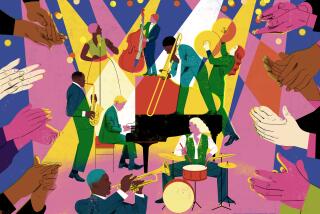David Grisman Melds Klezmer, ‘Dawg’ Music
- Share via
The connections between Jewish traditional music and American jazz, pop and folk have been both remarkably strong and remarkably unnoticed. It was probably no accident that two of the most important leaders of big jazz bands--Benny Goodman and Artie Shaw--were Jewish clarinetists who came to maturity at a time when klezmer bands, with their brisk rhythms and soaring clarinet lines, were popular in the Jewish community.
Mandolinist David Grisman decided to explore the connections between Jewish traditional songs, with their devotion to God and Judaism, and his own eclectic folk-jazz style a few years ago. Wednesday, at the Veterans Wadsworth Theater, he demonstrated how appealing those linkages can be.
Grisman was originally scheduled to perform with clarinetist-mandolinist Andy Statman. The duo has collaborated on a number of recordings, including “Songs of Our Fathers,” which became the basis for the Wadsworth program. But Statman’s reported problems with asthma prevented him from making the concert, and he was replaced by one of his accomplished students, Fishel Bresler.
The result was a captivating set of performances that had a sold-out house applauding individual solos with all the enthusiasm of a crowd at a jazz concert. Grisman and Bresler were accompanied by Grisman’s regular musical associates--guitarist Enrique Coria, violinist Joe Craven, bassist Jim Kerwin and drummer Hal Blaine--and wisely leavened the program with selections from Grisman’s rhythmically irresistible “dawg” music.
Bresler played the compelling melodies of the traditional Jewish tunes with the little vocalized turns and glissando-rich phrasing typical of the style. But he was less effective in the “dawg music” segments.
Fortunately, Grisman’s band easily filled in the gaps. Craven is a superb violinist, whose soloing called up frequent references to Stuff Smith and Stephane Grappelli. Bassist Kerwin played the arco-styled accompaniments of the traditional tunes with precise accuracy, then switched easily to the walking rhythms of Grisman’s music. And Blaine not only offered solid rhythmic support, he also stepped to the microphone to offer a set of Catskills humor.
By the concert’s close, the connections Grisman was attempting to make between traditional Jewish music and his own vision of pop/folk/jazz were effectively established. Best of all, they were made, not via arcane explanations and definitions, but by an entertaining evening of unusual music.
More to Read
The biggest entertainment stories
Get our big stories about Hollywood, film, television, music, arts, culture and more right in your inbox as soon as they publish.
You may occasionally receive promotional content from the Los Angeles Times.










